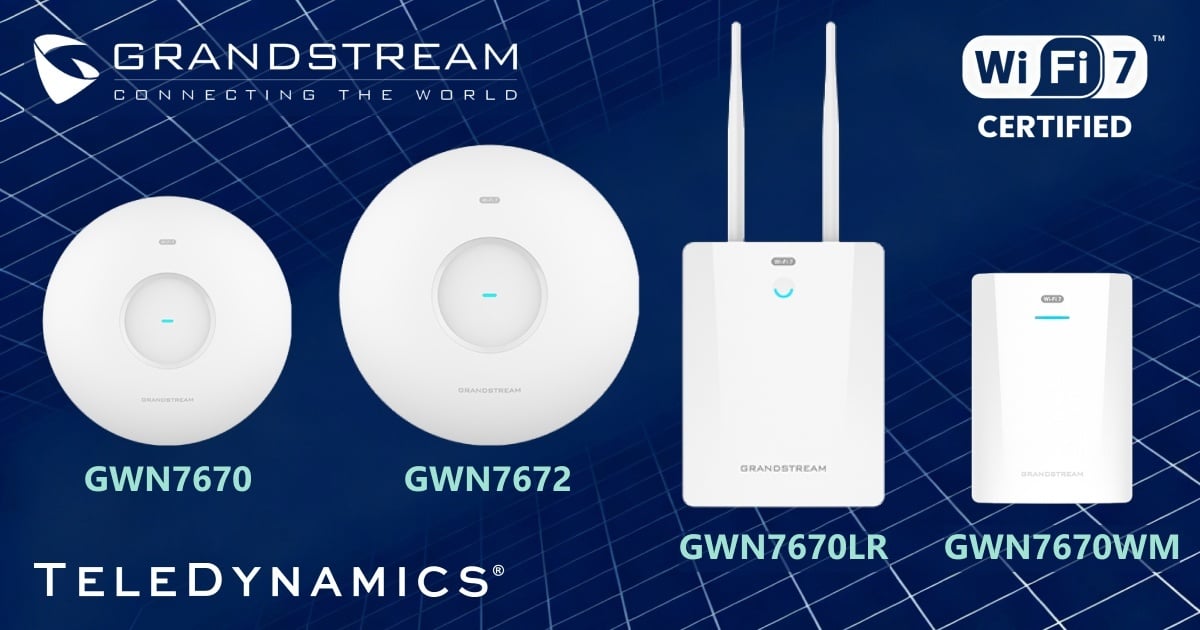Wi-Fi 7 is a game-changing advancement for Wi-Fi networks, and Grandstream has gone all out to take advantage of its capabilities. With the GWN7670 series of wireless access points, Grandstream offers the performance, flexibility, and reliability that modern wireless networks demand.
In this article, we review these extraordinary devices, highlighting the most recent additions, the GWN7670WM and GWN7670LR, and underscoring the most noteworthy features and functions they offer to businesses of all types seeking to deploy robust and reliable wireless networks.
Read More
Topics:
VoWi-Fi,
Wireless,
Grandstream,
Product Review,
Wi-Fi
Do you have a telephony deployment scenario where workers juggle multiple devices to make calls, scan barcodes, and assist customers—often in environments where speed and reliability are non-negotiable? If so, there's a smarter, more efficient solution on the market. Whether you're outfitting a warehouse, a hospital, or a retail floor, the Grandstream WP856 Wi-Fi smartphone consolidates voice, data, and scanning into one rugged, enterprise-grade device.
In this article, you’ll discover how this all-in-one solution can simplify your clients’ operations, reduce hardware overhead, and deliver real productivity gains—making it an easy win for your next deployment.
Read More
Topics:
VoWi-Fi,
SIP Phones,
Wireless,
Grandstream,
Mobility (including remote work),
Productivity,
Product Review,
Wi-Fi
The world of wireless communications just got much faster with the recent release of Grandstream's newest GWN7665 tri-band Wi-Fi access point. This revolutionary device delivers unprecedented speeds, network capacities, and connectivity ranges compared to its predecessors and competitors. This article reviews this device and highlights some of its most promising features.
Read More
Topics:
VoWi-Fi,
Grandstream,
Product Review,
Wi-Fi
Wireless communication based on the Wi-Fi family of technologies has been around for over two decades. During this time, many innovations have been introduced into this standard, making it an essential part of today's data and voice networks.
In this article, we examine the latest Wi-Fi trends and what we can expect in the near future.
Read More
Topics:
VoWi-Fi,
Wireless,
Mobility (including remote work),
Mobile,
Wi-Fi,
Regulations
Many administrators resist implementing VoIP over Wi-Fi, often citing security and quality concerns. The truth is that if implemented correctly, voice can be safely and reliably deployed on a wireless network. This article examines some best practices for optimizing voice over Wi-Fi (VoWi-Fi).
Read More
Topics:
VoWi-Fi,
QoS,
Wireless,
Network Security,
Network Design,
Wi-Fi,
Unified Communications
By Phil Bowers, Senior Marketing Manager, Grandstream
A new trend is beginning to develop within the business communications industry. Being driven largely by enterprises looking to streamline internal networks by eliminating wiring, voice over Wi-Fi (VoWi-Fi) could be the next major advancement within the VoIP industry. It features the same exact backend hosted, cloud, or SIP trunk services as any wired voice-over-IP (VoIP) network, but with the connections being extended to endpoints through an immersive Wi-Fi network rather than an endless maze of Ethernet cabling.
Here at Grandstream, we are leading the Wi-Fi voice trend through a variety of initiatives and solutions designed to allow businesses to build powerful VoWi-Fi networks that increase productivity, streamline installation and management, and offer eco-friendly benefits. This article will introduce the Wi-Fi voice trend, cover the reasons many businesses are adopting Wi-Fi voice networks, combat a major Wi-Fi voice concern, and highlight the Wi-Fi voice solutions we offer at Grandstream.
Read More
Topics:
VoWi-Fi,
Wireless,
VoIP,
Total Voice Solution,
Grandstream,
Wi-Fi
By Stefan Eriksson, Marketing and Communications Manager of Konftel
Remote meetings with poor quality audio are often exhausting. Misunderstandings become more likely because it’s difficult to hear nuances and other subtleties in conversation. So you want to aim for the best sound quality possible during teleconferences. The following is a quick explanation of different technical requirements for audio quality.
- A purely mobile solution gives you great flexibility and mobility, but sometimes at the expense of sound quality. Many mobile operators now offer HD Voice in their networks, which delivers HD audio if the phone supports the technology.
- Traditional analog telephony delivers an acceptable sound quality, but with limitations in frequency range. Sometimes known as telephone quality or narrowband.
- VoIP, i.e., digital telephony via the data network (voice over IP), allows for extended frequency range, but with some compression. IP makes it possible to achieve superior audio quality, also called HD audio or wideband.
- Remember that all local networks and accessories, e.g. Wi-Fi, DECT (wireless telephony) or Bluetooth®, affect the transmission capacity and can have an adverse impact on the sound quality.
- All of Konftel’s phones and conference units offer HD audio in contexts where PBXs and networks support it.
Read More
Topics:
VoWi-Fi,
QoS,
Wireless,
VoIP,
Total Voice Solution,
DECT
Some businesses do a good job of securing their data network (local area network or LAN) but forget to secure their wireless network. Despite all the pains they took to secure their LANs, their network is as vulnerable to entry as a locked car with the windows rolled down. Wi-Fi network security is a common blind spot, especially for small businesses. Here we look at some basic steps companies can take to lock down their Wi-Fi networks.
Read More
Topics:
VoWi-Fi,
Business Telephone System,
Network Security
For many types of businesses, workforce mobility is indispensable. Wireless technology allows associates to communicate internally and externally without being bound to a desk or station. Traditionally, DECT (digital enhanced cordless telecommunications) has been the technology used for this purpose. More recently, as wireless local area networks (WLANs) have become more commonplace, voice over WLAN (VoWLAN or VoWi-Fi) has emerged as an increasingly utilized technology.
Read More
Topics:
VoWi-Fi,
Wireless,
Business Telephone System,
VoIP,
SIP,
Cordless










.jpg)






